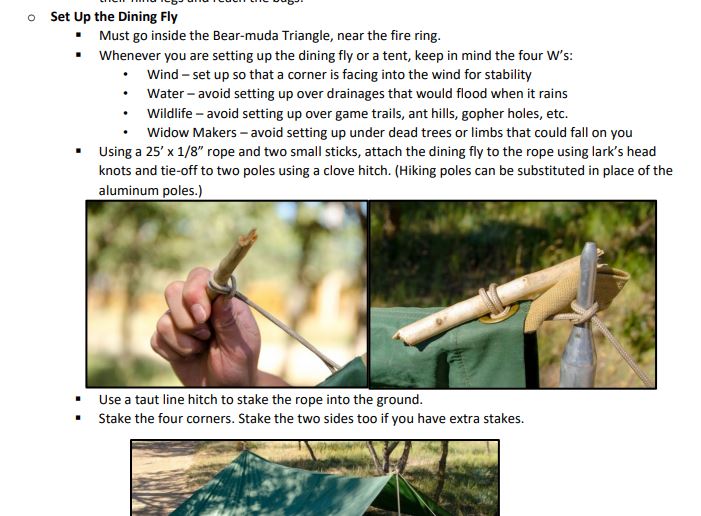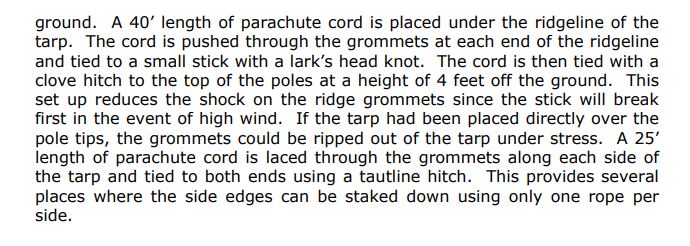Topic
Pre-tie Dining Fly Knots (Or.. The 'stick breaks first' is silly)
Forum Posting
A Membership is required to post in the forums. Login or become a member to post in the member forums!
Home › Forums › Scouting › Philmont › Pre-tie Dining Fly Knots (Or.. The 'stick breaks first' is silly)
- This topic has 13 replies, 9 voices, and was last updated 4 years, 8 months ago by
 James A.
James A.
-
AuthorPosts
-
Mar 30, 2019 at 1:52 pm #3586218
Let’s talk about a <span style=”text-decoration: underline;”>trivial</span> topic… tieing the dining fly knots.
The Shakedown Guide shows:


and the Philmont Advisor’s Guide says “This setup reduces the shock on the ridge grommets since the stick will break first in the event of high wind.”
That is just plain silly. The force required to break the stick is far greater than every other parts’ strength. The other annoying part of this rig is that it must be tied fresh every time. Also, unless set up perfectly each time by tired Scouts it negates the entire reason for the stick – to relieve stress on the tarp.
So, how about this faster, simpler, safer rig? First, tie a loop at each end of the tarp (say with a Figure 8). The loop needs to be big enough to wrap around your pole a few times. The length between the two loop knots is critical. You want all the force pulling on ridgeline to be in the rope, not the tarp itself. Using non-stretch Spectra or Dyneema cord makes this easy…. using stretching nylon or paracord will take some experimenting. Test with your specific tarp to confirm the line can be plucked like a guitar but the tarp is still loose. Lastly, you’ll want 14-18′ feet of line on each end to run to the stake. To adjust the tension on the line to the stake, you could use a tautline hitch but modern devices are cheap, faster, simpler, and about as heavy.

The set-up then looks like:

To pack up, wrap the ridgeline rope around its two, large stakes. To set up, prep your trekking poles (see another post), run the ridgeline, tie the tarp to the poles, and then using two people one plants the stakes while the other keeps the ridgeline up. The ridgeline is very taut, the tarp hangs over the ridgeline somewhat loosely, and then stakes on side & corners pull the dining fly down, stretching it to shed wind and rain.
Bonus points — Use adjustable trekking poles and highly adjustable lines on the sides/corners so your dining fly could be rigged high to stand under or low for storm-mode.
Fast, simple, strong.
Comments?
Mar 30, 2019 at 6:31 pm #3586265You do not have to use a Philmont issued dining tarp, however, if you do the ranger will teach you the Philmont method. It’s their gear so they prefer you do it their way. Again, that’s if you use their dining fly. In 2016 we bought our own, same square foot size, almost half the weight and packed much smaller; and because it was our gear, the method of set up was up to us. We will be doing the same thing this year.
Mar 30, 2019 at 7:37 pm #3586276I’ve only dealt with three of their rangers but I’d say there IS variability in their flexibility. But it isn’t smart to expect a lot because you don’t know what kind of ranger you’ll get.
Perhaps the stick idea will protect the grommet of the stick is skinny enough … much skinnier than in their photo.though.
For myself there is no room for grommets in a tarp. If you can get close enough to a sailboat take a look at what is required to be a grommet that will not fail in a too strong wind … not light, much less ultralight.
I like Kevin’s idea except that it does not help the other grommets. If there are a LOT of side grommets it might be ok if every one is staked out.
There is a tarp maker near here who started out making tarps for canoe expeditions north of the tree line (tundra rivers) where there is no windbreak between you and the horizon. You can see his solution on his Tundra Tarps
If his prices are beyond your pain point and you know a sewing machine owner I can say from experience that the construction method is easily doable for one with an MYOG bent. The two I’ve made used grosgrain instead of webbing for the perimeter and guyout loops and they survived a wind that turned aluminum canoes into kites (guy lines running to deadmen buried in the sandbar on every side loop).
Mar 30, 2019 at 8:40 pm #3586285and the Philmont Advisor’s Guide says “This setup reduces the shock on the ridge grommets since the stick will break first in the event of high wind.”
I could’nt find that written in the Advisors Guide. This is what the guide says:

 Mar 30, 2019 at 8:52 pm #3586288
Mar 30, 2019 at 8:52 pm #3586288Oops! With further reading I did find this:
 Mar 30, 2019 at 9:45 pm #3586295
Mar 30, 2019 at 9:45 pm #3586295Bring a silnylon tarp with sewn on webbing loops, not grommets available from Oware Gear, Rabb, Mountain Laurel Designs and elsewhere.
Mar 31, 2019 at 3:21 am #3586320A silnylon tarp is the way to go. We attached ours to the ridge line with prusik knots. This allowed us to move the tarp along the ridge line to center it over the area we wanted. Each side of the tarp had three tie out points. With the use of a truckers hitch with a slippery knot setting up the tarp was not problem.
Mar 31, 2019 at 3:23 pm #3586346We’re bringing our own silnylon dining fly. The guy lines will already be attached and it doesn’t have grommets.
My assumption is we will set it up high as an A frame with trekking poles strapped together at each end in good weather and low with a single pole at each end in rain. Stake out the pole guy lines and the 4 corners and the side guy lines as needed.
Is there any reason this won’t work? Using trekking poles we should be able to set up wherever we have space.
Mar 31, 2019 at 5:56 pm #358636210 points to Jeffrey Peters for the Prusiks-on-ridge-line idea.
More easily rigged – just unroll the ridgeline line with the tarp, but still need to tie a (clove) hitch onto the pole. Easily adjusted, just enough tension on the fly and doesn’t force one to be centered on the very long ridgeline rope. TBD if a particular brand of line offers enough friction to keep taut but not so much to stress the tarp.
That’s just the innovation I was hoping would come out with this post.
Mar 31, 2019 at 6:00 pm #3586363Brad P, that’s exactly how we roll, same rigging, exact same Paria tarp too. Just run a ridgeline to keep stress off the tarp itself.
My post was just about the very trivial aspect of tying the tarp to the ridgeline to the pole .. what’s fast, simple, and prevents Scouts from over-stressing the tarp. (Scouts will ruin a fly far faster than a storm by pulling the ridge too tight.) …. but it seems any mention of dining flies spins back into same old topics. (Not good, not bad, just is.)
I’m going to rig up the Prusik idea in the backyard… see if my particular brand of line has enough friction.
Mar 31, 2019 at 6:40 pm #3586368I might have phrased the question part poorly. I haven’t been there, so I just want to make sure our setup will work at all camps. I assume we won’t have to do anything more than an A frame with trekking poles at each camp site. Just trying to scratch things off the prep checklist.
I appreciate all the advice here!
Mar 31, 2019 at 7:28 pm #3586381Jim,
I’m totally for Cooke Custom Sewing (CCS); their label has adorned much of my BWCA gear for decades. But for that realm, I prefer the heavier, tougher https://www.crazycreek.com/ba-tarp-standard/
Aug 6, 2019 at 1:56 pm #3604981@sweerek, my Crew is also looking at the Paria SilTarp for our trek next summer. How did yours work out? Any durability concerns? Thanks!
Aug 13, 2019 at 2:19 pm #3605885FWIW, I carried around a Philmont MSR dining fly during our trek earlier this summer. It’s a bit bulky, but I have a big pack, so not a problem. Weight wasn’t bad, either. It is very waterproof.
I wouldn’t recommend buying a fly unless you plan on using it after Philmont. Otherwise it’s not worth it.
-
AuthorPosts
- You must be logged in to reply to this topic.
Forum Posting
A Membership is required to post in the forums. Login or become a member to post in the member forums!
Our Community Posts are Moderated
Backpacking Light community posts are moderated and here to foster helpful and positive discussions about lightweight backpacking. Please be mindful of our values and boundaries and review our Community Guidelines prior to posting.
Get the Newsletter
Gear Research & Discovery Tools
- Browse our curated Gear Shop
- See the latest Gear Deals and Sales
- Our Recommendations
- Search for Gear on Sale with the Gear Finder
- Used Gear Swap
- Member Gear Reviews and BPL Gear Review Articles
- Browse by Gear Type or Brand.









